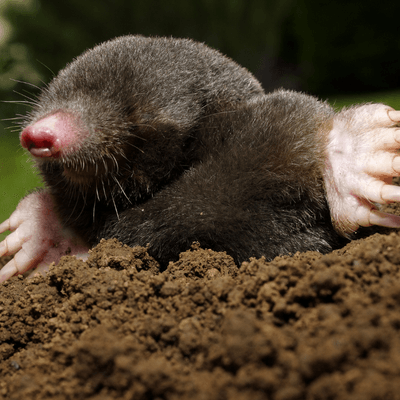
Slide title
Write your caption hereButton
Mole Control
Mole Control
The main thing you'll notice if moles enter your property is what a nuisance they can be. Moles are half-pound mammals that reach about nine inches in length and are best known for their elaborate networks of tunnels. Since they spend most of their time underground, their eyes are small and colorblind, though they're excellent at perceiving light. They don't have external ears because otherwise, they'd fill with dirt as the creatures dig. To help with the digging, they have an extra thumb on both of their front legs.
Common moles prefer dry soil for their excavation process and are known to destroy lawns and gardens since it tears up roots. The collection of dirt, known as the molehill, at every entryway and exit is unsightly and can interfere with lawn maintenance.
These creatures dig several tunnels between six and 18 inches below the surface as the omnivores search around for food. Earthworms seem to be their favorite; they've even been known to prepare them in specific ways, squeezing them to push out excess dirt and improve the meal's flavor. Moles have also been known to capture their food ahead of time and store it so they can snack later on. Some have been found with hundreds of earthworms tucked away. Some species can hunt those creatures quickly. One of Wisconsin's common species, the Star-Nosed Mole, is the fastest hunter in the mammal kingdom, catching and eating its prey in under a quarter of a second.
Since moles keep primarily to themselves, they don't have many natural predators to keep their population sizes at bay. Trapping moles can be challenging. They're naturally suspicious and won't approach something out of the ordinary in their tunnel. Tearing up a tunnel to plant the trap is also a dead giveaway that you're after them, and they'll dig elsewhere to avoid the run-in.
You can take steps to discourage moles from being interested in your property. Spilled birdfeeders should be cleaned up, and you should remove pet food or other possible mole treats from the yard. Wisconsin's Wildlife Damage Abatement and Claims Program can help pay for the losses if you've had significant agricultural damage. However, having a pest control expert inspect your property, get rid of the pests, and help guide you through how to keep them from coming back should be your top choice.
https://dnr.wisconsin.gov/topic/WildlifeHabitat/damage
Regarding
pest control, you'll find no better company in southwest Wisconsin than 1st Defense Pest Solutions. Our business is owned by people who live in the same community as you, and we're kept accountable by our customers. Our reputation as the top pest control service in La Crosse and the surrounding area means everything to us. Our hard work keeps the five-star reviews coming in, and we go above and beyond to ensure our customers are happy and their problems are solved. We also serve Minnesota counties, Winona, Houston, and Fillmore.
Contact us today for an estimate or more information on our pest and wildlife services.
All Rights Reserved | 1st Defense Pest Solutions
